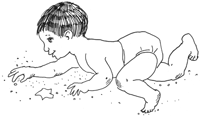STRANGE BUT TRUE- Recent invention: What's behind the baby's crawl

DRAWING BY DEBORAH DERR McCLINTOCK
Q. What do our babies do today that they didn't used to do so much and still don't in parts of the world? –D.Spock
A. They crawl. In a key study of Bangladesh children, anthropologist David Tracer concluded that crawling significantly increases the risk from contact with ground pathogens, such as those causing diarrhea, says Kate Wong in Scientific American. The risk from predators also becomes much greater during crawling. Tracer contends "the crawling stage is a recent invention– one that emerged only within the past century or two, after humans began living in elevated houses with flooring, which would have been more hygienic than dirt."
Amazingly, babies of the Au hunter-gatherers of Papua New Guinea skip the crawling stage altogether. Instead, parents carry them everywhere– without any apparent ill effects. Tracer found that babies were carried upright in a sling 80 to 90 percent of the time, and on those rare occasions when mothers put them on the ground, they were propped up in a sitting position rather than placed on their stomachs. As a result, Au kids never learn to crawl, though they do go through a "scooting" phase of energetic "bottom-sliding."
And Au kids are not alone. It's the same in other traditional societies, such as in Paraguay, Indonesia, and Mali. Anthropologist Wenda Trevathan agrees that babies were probably rarely placed on the ground in the past and stresses how easily we can fall into the mythology of judging all human infants based on Western cultures.
Q. Have you committed "lactomangulation" in your time? Yes or no, you can thank comedian Rich Hall for the term. –L. Pasteur
A. The multinational company Tetra Pak revolutionized the food and drink industry with its unique carton production in the 1940s, says Jack Challoner in 1000 Inventions that Changed the World. Work began in 1943 to
develop a new storage medium for milk, previously sold only in glass bottles, in hopes of providing a hygienic container using minimal materials. The challenge for many consumers, however, was getting the boldly geometrical new container to open for pouring and then to close again (and again) without getting lactomangulated. Enter Rich Hall with his zany term for "manhandling the 'open here' spout on a milk carton so badly that one has to resort to using the 'illegal side.'"
Proving once again that our highly linguistic species can find the joke in almost anything.
Q. Who's the 16th-century diplomat and scholar many folks have lit up for pleasure– eponymously, at any rate? –G. Chaucer
A. Frenchman Jean Nicot de Villemain (1530-1600), whose name became an eponym for nicotine after he introduced the substance into France, says David Crystal in The Cambridge Encyclopedia of the English Language. Eponyms are personal names used to form new general words, including also the following:
VOLT: the unit of electrical potential difference and electromotive force, from Italian physicist Alessandro Volta (1745-1827), inventor of the electric battery
CARDIGAN: knitted jacket fastened with buttons, from English cavalry officer James Brudenell, seventh Earl of Cardigan (1797-1868)
MAVERICK: an independent person who refuses to conform, after U.S. pioneer Samuel Augustus Maverick (1803-1870), who did it his way by not branding his calves
TEDDY BEAR: soft toy bear, from U.S. president Theodore "Teddy" Roosevelt (1858-1919), after a cartoon depicted this well-known bear-hunter sparing the life of a cub.
~
Send Strange questions to brothers Bill and Rich at [email protected].
#